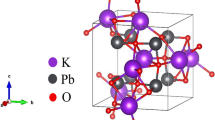Abstract
A local density approximation (LDA) band structure method, the Linear Muffin-Tin Orbital Atomic Sphere Approximation (LMTO-ASA) method has been used to calculate the electronic structures of the pyrite-type disulphides (MS2, where M = Mn, Fe, Co, Ni, Cu, Zn). The total density of states has been calculated for 10 eV above and below the Fermi Level, along with the separate contributions from metal and sulphur and shows that the metal d band occurs above the sulphur p bands in MnS2, FeS2, CoS2 and NiS2, whereas in CuS2, the d band passes through the sulphur p band and in ZnS2, it lies below the sulphur p band. Substantial hybridization of the metal d states with the sulphur states occurs. FeS2 is calculated to be a semiconductor with a direct band gap of 0.64 eV in good agreement with experiment. The calculated local densities of states have been used in turn to calculate X-ray photoelectron spectra and Bremsstrahlung Isochromat spectra for this series of compounds, and these also show reasonable agreement with experimental data. A particular strength of the LMTO-ASA method is the ability to calculate and predict certain bulk properties of solids of interest in mineral physics. This has enabled the first reasonably accurate calculations of the total energy of the valence electrons of the system for pyrite (FeS2), given as — 345.885 rydbergs per unit cell, and the equilibrium unit cell volume which is within 3.3% of that determined experimentally. A theoretical pressure vs. volume curve for pyrite was also calculated along with values for the bulk modulus. However, our calculations predict a bulk modulus of 6.75 Mbar which is too high by a factor of 4.6 due to the simplifying assumption of a uniform scaling of interatomic distances on compression.
Similar content being viewed by others
References
Andersen OK (1975) Linear methods in band theory. Phys Rev B12:3060–3083
Andersen OK (1981) New methods for the one-electron problem. Europhys News 12(5): 4–8
Andersen OK (1984) The Electronic Structure of Complex Systems. Phariseau P, Temmerman WM (eds) NATO ASI Series. Phys B113:11–30 Plenum Press, New York
Andersen OK, Jepsen O, Glotzel D (1985) Highlights of condensed matter theory. Bassani F, Fumi F, Tosi MP (eds) North-Holland, Amsterdam
Braga M, Lie SK, Taft CA, Lester WA (1988) Electronic structure, hyperfine interactions, and magnetic properties for iron octahedral sulfides. Phys Rev 38:10837–10851
Bullett DW (1982) Electronic structure of 3d pyrite- and marcasite- type sulphides. J Phys C15:6163–6174
Craig JR, Vaughan DJ (1981) Ore microscopy and ore petrography. Wiley, New York
Folkerts W, Sawatzky GA, Haas C, de Groot RA, Hillebrecht FU (1987) Electronic structure of some 3D transition-metal pyrites. J Phys C20:4135–4144
Harris S (1982) Study of the electronic structure of first and second row transition metal sulfides using SCF-SW-α cluster calculations. Chem Phys 67:229–237
Lauer S, Trautwein AX, Harris FG (1984) Electronic structure calculations, photoelectron spectra, optical spectra and Mössbauer parameters for the pyrites MS2 (M = Fe, Co, Ni, Cu, Zn) Phys Rev B29:6774–6783
Li EK, Johnson KH, Eastman DE, Freeouf JL (1974) Localized and bandlike valence-electron states in FeS2 and NiS2. Phys Rev Lett 32:470–472
Sato K (1985) Pyrite type compounds — with particular reference to optical characterization. Prog Cryst Growth Charact 11:109–154
Skriver HL (1984) The LMTO method. Springer, Berlin Heidelberg New York
Tossell JA, Vaughan DJ, Burdett JK (1981) Pyrite, marcasite and arsenopyrite type minerals: crystal chemical and structural principles. Phys Chem Minerals 7:177–184
Tossell JA, Vaughan DJ (1992) Theoretical geochemistry. Applications of quantum mechanics in the earth and mineral sciences. Oxford University Press, New York
Vaughan DJ, Craig JR (1978) Mineral chemistry of metal sulfides. Cambridge University Press, Cambridge
Vaughan DJ, Tossell JA (1983) Electronic structure of sulphide minerals: theory and experiment. Phys Chem Minerals 9:253–262
Winter H, Durham PJ, Stocks GM (1984) Theory of valence band XPS spectra of random alloys: application to Ag x -Pd1-x . J Phys F14:1047–1060
Author information
Authors and Affiliations
Rights and permissions
About this article
Cite this article
Temmerman, W.M., Durham, P.J. & Vaughan, D.J. The electronic structures of the pyrite-type disulphides (MS2, where M = Mn, Fe, Co, Ni, Cu, Zn) and the bulk properties of pyrite from local density approximation (LDA) band structure calculations. Phys Chem Minerals 20, 248–254 (1993). https://doi.org/10.1007/BF00208138
Received:
Revised:
Accepted:
Issue Date:
DOI: https://doi.org/10.1007/BF00208138




